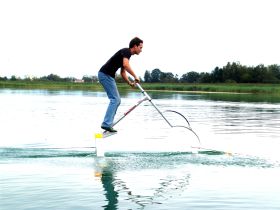Human-powered Hydrofoil on:
[Wikipedia]
[Google]
[Amazon]
 A human-powered hydrofoil is a small hydrofoil
A human-powered hydrofoil is a small hydrofoil
human-powered-hydrofoils.com - Human powered hydrofoil designs from 1953 to presentHow to "Fly" a Human Powered Hydrofoil - the "Aquaskipper"www.instructables.com
{{Human-powered vehicles Human-powered vehicles Hydrofoils
 A human-powered hydrofoil is a small hydrofoil
A human-powered hydrofoil is a small hydrofoil watercraft
Any vehicle used in or on water as well as underwater, including boats, ships, hovercraft and submarines, is a watercraft, also known as a water vessel or waterborne vessel. A watercraft usually has a propulsive capability (whether by sail, ...
propelled entirely by the muscle power of its operator(s). Hydrofoils are the fastest water-based vehicles propelled solely by human power. They can reach speeds of up to ,
easily exceeding the world records
A world record is usually the best global and most important performance that is ever recorded and officially verified in a specific skill, sport, or other kind of activity. The book ''Guinness World Records'' and other world records organization ...
set by competitive rowing
Rowing is the act of propelling a human-powered watercraft using the sweeping motions of oars to displace water and generate reactional propulsion. Rowing is functionally similar to paddling, but rowing requires oars to be mechanically ...
which stand at about . This speed advantage is achieved since hydrofoils lack a submerged body to provide buoyancy
Buoyancy (), or upthrust, is an upward force exerted by a fluid that opposes the weight of a partially or fully immersed object. In a column of fluid, pressure increases with depth as a result of the weight of the overlying fluid. Thus the p ...
, greatly reducing the drag force.
Propulsion
Means of propulsion includescrew propeller
A propeller (colloquially often called a screw if on a ship or an airscrew if on an aircraft) is a device with a rotating hub and radiating blades that are set at a pitch to form a helical spiral which, when rotated, exerts linear thrust upon ...
s, as in hydrocycle
A hydrocycle is a bicycle-like watercraft. The concept was known in the 1870s as a water velocipede and the name was in use by the late 1890s.
Power is collected from the rider via a crank with pedals, as on a bicycle, and delivered to the ...
s; aircraft propellers
An aircraft propeller, also called an airscrew,Beaumont, R.A.; ''Aeronautical Engineering'', Odhams, 1942, Chapter 13, "Airscrews". converts rotary motion from an engine or other power source into a swirling slipstream which pushes the propeller ...
, as in the Decavitator; paddle
A paddle is a handheld tool with an elongated handle and a flat, widened distal end (i.e. the ''blade''), used as a lever to apply force onto the bladed end. It most commonly describes a completely handheld tool used to propel a human-powered w ...
s, as in a Flyak The Flyak is a hydrofoil adaptation to the conventional kayak. It uses twin hydrofoils designed to raise the hull out of the water to increase the speed. Speeds of up to 27.2 km/h (7.6 m·s−1, 16.9 mph) can be achieved ...
; oars, as in the Yale hydrofoil sculling project; and flapping wings, as detailed below.
Flapping wing propulsion
Flapping wing propulsion devices are hydrofoils that produce propulsion by forcing a foil to move up and down in the water. The forward motion of the foil then generates lift as in other hydrofoils. A common design consists of a large foil at thestern
The stern is the back or aft-most part of a ship or boat, technically defined as the area built up over the sternpost, extending upwards from the counter rail to the taffrail. The stern lies opposite the bow, the foremost part of a ship. Ori ...
that is used both for propulsion and keeping the passenger above the water, connected to a smaller foil at the bow used for steering and longitudinal stability. Riders operate the vehicle by bouncing up and down on a small platform at the stern, whilst holding onto a steering column.
It is started and landed from the shore, or preferably from a dock, and requires a bit of experience. When moving too slowly, it will sink, and the range of possible speeds is .
Several variations on the design have been developed:
*The ''Wasserläufer'' was a forerunner of the design developed in Germany during the 1950s.
*The ''Flying Fish'' was developed by Allan Abbott and Alec Brooks in 1984.
*The ''Pogofoil'', with pontoons for flotation, was developed in the US in 1989.
*The ''Trampofoil'' was developed in Sweden in 1998.
*The ''AquaSkipper'' was developed the US in 2003.
*The ''Pumpabike'' was developed in South Africa in 2004.
Electric assist hydrofoils
*The Hydrofoiler XE-1 is a Hydrofoil electric bike developed in New Zealand in 2011 onwards.References
External links
human-powered-hydrofoils.com - Human powered hydrofoil designs from 1953 to present
{{Human-powered vehicles Human-powered vehicles Hydrofoils